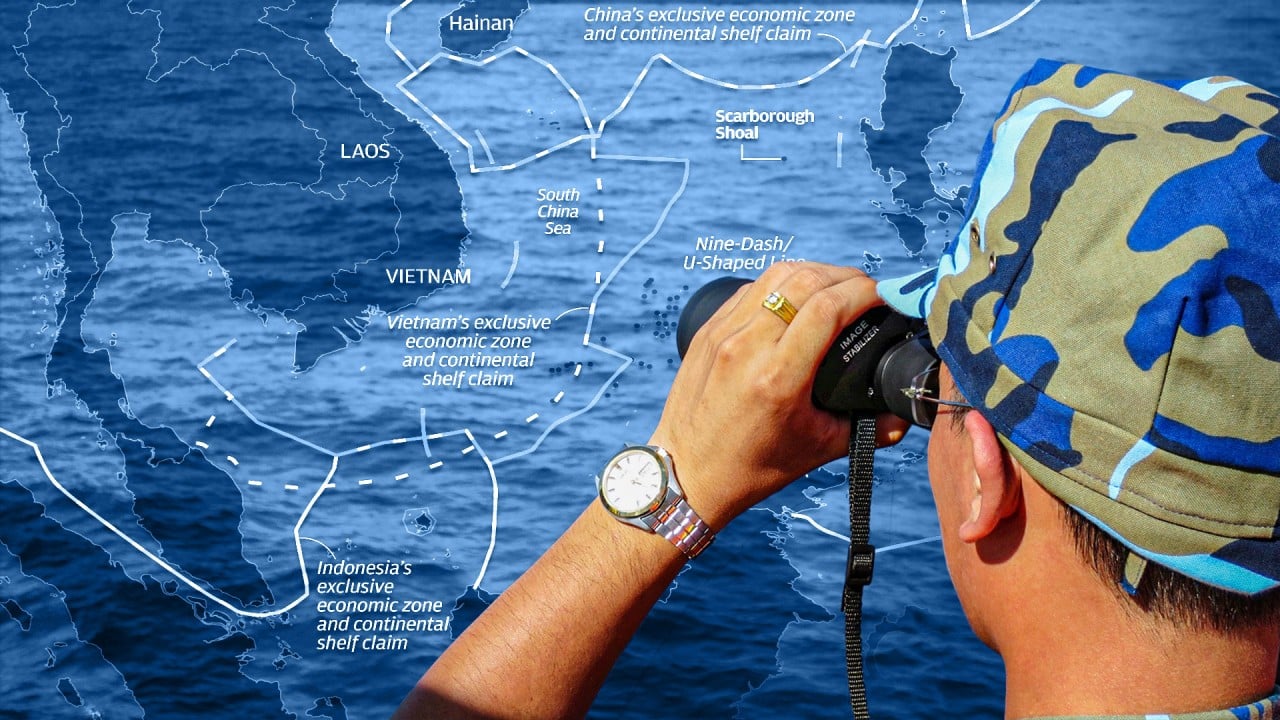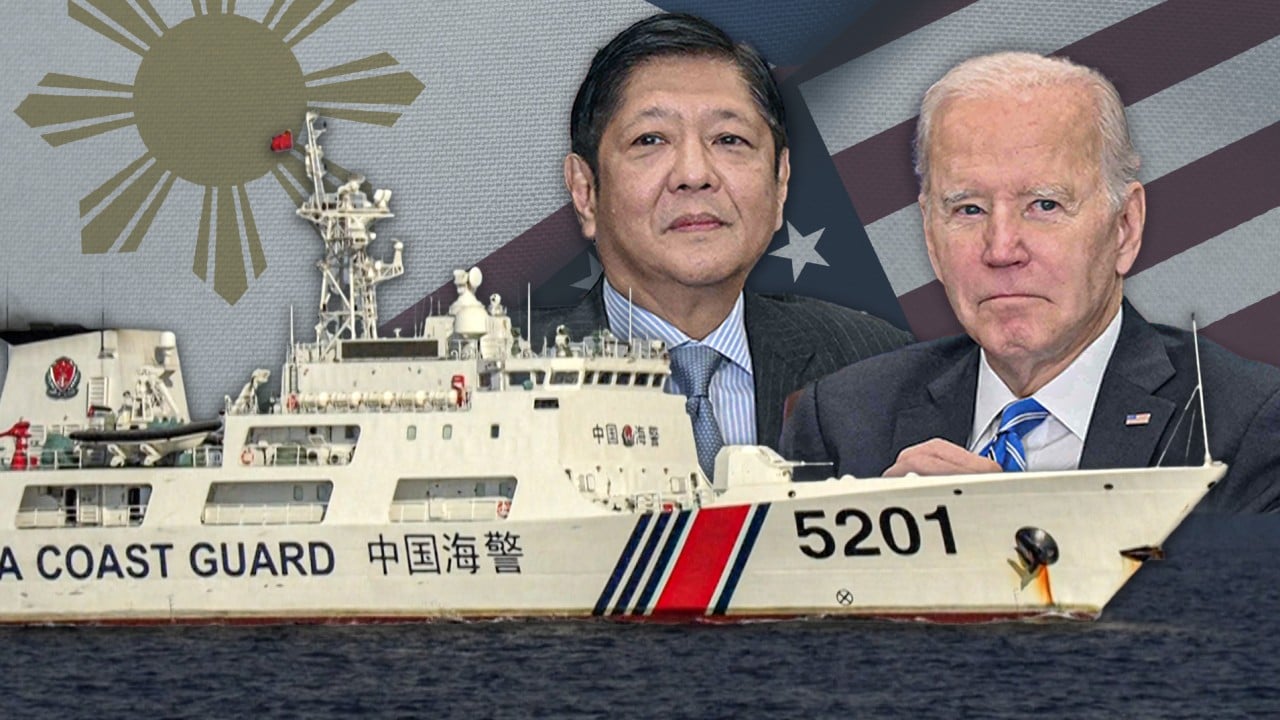Tensions are mounting in the South China Sea – a hotly contested and globally significant waterway that’s become a flashpoint for conflict. In the first instalment of a four-part series we look at why it’s so critical for Beijing.
Boiling tensions between Beijing and Manila have given disputes over the South China Sea new prominence, with analysts warning that hostilities could escalate and regional polarisation may worsen.
Beijing’s approach to asserting its sovereignty claims to most of the waterway – often at the expense of its neighbours – is back in the spotlight, as China increasingly views these territorial disputes through the lens of its rivalry with the US.
It is not just rocks, reefs and resources at stake. The South China Sea is rich in oil, natural gas and fish, but it is also one of the world’s busiest shipping routes, through which more than 20 per cent of global trade passes.
China’s expansive territorial claims in the South China Sea overlap with those of the Philippines, Vietnam, Malaysia and Brunei.
For these smaller neighbours, their sovereign rights, fisheries and economic livelihoods are on the line. For Beijing, it is more about vital shipping lanes, deep-sea exploration, its goal for “reunification” with Taiwan, and even the future regional and global order, analysts say.
While Beijing emphasises its sovereignty over the South China Sea, its maritime interests extend beyond territorial claims, according to a senior researcher from the government-linked Chinese Academy of Social Sciences (CASS), who spoke on condition of anonymity.
But that does not mean China wants to close off the sea route or reclaim every island and reef. “The sea lanes must remain open for trade and commerce, and ensuring freedom of navigation is crucial for China’s outward-oriented economy,” the researcher said.
The South China Sea also serves as a gateway to the deep sea – key to Beijing’s ambition to transform its navy from a coastal defence force into one of the world’s largest blue-water fleets.
Noting the shallow waters of both the Yellow Sea and East China Sea and other unfavourable conditions, the researcher said China “needs to further increase its presence in the South China Sea, which provides a strategic channel for Chinese navy ships and commercial vessels to go out”.
They said the South China Sea was also crucial for the country’s security in the region as it needed the support of neighbouring countries while countering US-led efforts to “encircle and contain” China.
“The significance of maintaining stability in the South China Sea has grown relative to China’s broader strategic interests,” the researcher said. “Given America’s heightened strategic presence in the region, China must also strengthen its own strategic position in the South China Sea.”
Ding Duo, an associate research fellow at the Hainan-based National Institute for South China Sea Studies, also noted the growing significance of the waterway and Beijing’s efforts to maintain stability while “protecting its sovereignty” over contested islands.
China claims sovereignty over four archipelagos in the South China Sea, including the Spratlys and Paracels – known in Chinese as the Nansha and Xisha islands.
But Maria Thaemar Tana, a non-resident fellow at the Stratbase ADR Institute in Manila, said the South China Sea was mainly about strategic control for Beijing.
“The South China Sea provides a buffer zone for China, which is critical given the US presence in the region. Controlling the area increases China’s military power and deters potential threats,” she said.
It also serves as a platform to project power further into the Pacific, an important part of establishing maritime trade routes under Beijing’s Belt and Road Initiative. “Controlling the South China Sea enables China to exert influence over these vital shipping lanes,” Tana said.
But she said an increasingly powerful China with a significant military presence in the region raises security concerns for the Philippines and other Southeast Asian claimants.
“China’s encroachment is seen as a violation of territorial integrity. In addition, fishing and resource extraction are crucial to their economies. China’s dominance puts their access to these resources at risk,” she said.
“Because they lack the military power to directly challenge China, they often rely on allies such as the United States for assistance and a rules-based order to deter Chinese aggression.”

Patrick Cronin, the Asia-Pacific security chair at Hudson Institute in Washington, said China’s interests in the South China Sea were mainly driven by fear and ambition.
“Beijing fears that outside powers might disrupt vital sea lines of communication. This concern is compounded by the prevailing domestic historical narrative that sees the world through the glasses of a century of humiliation,” he said.
Then there are Beijing’s ambitions. “A core PLA mission is to be prepared soon to forcibly unify Taiwan, should [Chinese President] Xi Jinping and the Communist Party deem it necessary,” he said.
According to Cronin, fortified artificial island reef outposts in the Spratly Islands and maritime peacetime confrontation operations against the Philippines are seen as stepping stones towards achieving control over the South China Sea and the so-called first island chain.
Beijing sees the first island chain – which runs from the Japanese mainland through Taiwan and the Philippines – as the first maritime line of defence against the US trying to contain China.
“These ambitions are deemed necessary by Xi to ensure Beijing will be able to act freely to unify Taiwan, a goal portrayed by the party as a prerequisite to national rejuvenation,” Cronin said.
According to Carl Thayer, emeritus professor at the University of New South Wales in Australia, Beijing’s geostrategic interest in the South China Sea has evolved with its ascendance as an economic and military power.
He said a turning point was Beijing’s 2009 submission to the United Nations of its nine-dash line map, and tensions with Hanoi and Manila had escalated “in scope and intensity ever since”.
The Philippines brought an arbitration case against China after Beijing seized Scarborough Shoal, or Huangyan Island in Chinese, in 2012. Four years later an international tribunal dismissed China’s claims.
Beijing refused to participate in the arbitration and rejected the ruling. It has also built six artificial islands in the Spratly archipelago.

Thayer said the future of regional order was at stake as the era of US primacy was challenged by China’s rise.
“First, China seeks to break through the US-dominated first island chain from Japan to the Philippines to shore up its deterrence against nuclear threats from the US,” he said.
“This means expelling US military presence from the Philippines and securing undetected passage of Chinese ballistic nuclear submarines from the mainland or Hainan Island to the western Pacific.”
He said Beijing would also try to disrupt the US alliance network with Japan, South Korea, Australia and the Philippines and the threat this poses to Beijing’s drive to bring self-ruled Taiwan under its control.
“Second, China seeks to negotiate a South China Sea code of conduct with Southeast Asian states that excludes states from outside the region in developing marine resources or engaging in military activities with regional states,” Thayer said.
“The US seeks to contain China by reinforcing its position in the first island chain so it can safeguard Taiwan’s independence by maintaining a military presence in and over the South China Sea as well as in the Philippines and northern Australia.”
He said China’s continued pressure on other littoral states would only raise tensions, intensify regional polarisation and likely scupper negotiations on the code of conduct. “The ball is now in China’s court,” he said.
Shi Yinhong, a professor of international relations at Renmin University in Beijing, said China appeared to have the upper hand over the Philippines with its “grey zone” tactics such as the coastguard’s use of water cannons against Philippine vessels.
But he said these pressure tactics had pushed its smaller neighbours closer to the US, Japan and others.
“China’s actions in the South China Sea have both positive and negative consequences and it’s likely that the negative ones may prevail,” he said.
According to the CASS researcher, what started as territorial disputes between Beijing and several littoral states has morphed into a showdown for regional supremacy between China and the US.
“China has attached unprecedented importance to the South China Sea, mostly as a result of growing global focus on the region and the concerted effort by the US, the Philippines and others [aimed at China],” the researcher said.
“The nature of the issue has transformed significantly, as the South China Sea has become primarily a theatre for the Sino-US strategic competition.”
The researcher said Washington’s Indo-Pacific strategy, launched during the Donald Trump administration, and a statement by Mike Pompeo in 2020 when he was secretary of state were among the biggest drivers behind the shift.
Pompeo marked the fourth anniversary of the 2016 ruling by backing China’s rival claimants in the South China Sea, accusing Beijing of trying to set up a “maritime empire”, and pledging to reject any attempt to impose “might makes right”.
“China is facing a delicate balancing act – it’s actually trying to manage the dispute with restraint and avoid any excessive escalation or a breakdown, which is not in China’s interests at all because heightened security tensions could disrupt regional cooperation,” the researcher said. “The tree wants to remain quiet but the wind simply won’t stop.”
Tana said ideological differences between China and the US would make it difficult to de-escalate tensions or reach any compromises.
Diplomats from China and the Philippines agreed early this month to “control disputes and differences” after eight Filipino sailors were said to have been injured in the worst clash between the two sides in months. The skirmish on June 17 took place near Second Thomas Shoal, known in China as Renai Jiao. The Philippines carried out a resupply mission on Saturday without “untoward incidents” after the two sides on July 21 reached a “provisional arrangement on humanitarian resupply of living necessities” for Filipino troops stationed on a grounded warship at the disputed shoal.
“Domestic pressure and nationalistic sentiments in China and Southeast Asian nations make it challenging to compromise or back down in the dispute,” Tana said. “The region is becoming more divided, with other neighbouring states preferring a neutral position but perceiving the Philippines’ actions as challenging China by bringing in the United States and consequently disrupting the regional balance of power.”
Cronin blamed China’s maritime ambition and the coastguard’s “aggressive and reckless” behaviour for the heightened tensions in the region.
“China wishes to dominate the South China Sea and Southeast Asia, while the United States simply wishes to deny any one power from dominating the region. Beijing wants greater control, while Washington seeks a stable balance of power,” he said.
“These two positions are not necessarily incompatible, but the way China is going about exercising its influence in the South China Sea threatens smaller neighbours and established rules and norms,” he added. “The obvious way to de-escalate is to halt aggressive maritime behaviour and use diplomacy to resolve or at least better manage disputed claims.”
Ling Bing, a professor of Chinese law at the University of Sydney, also said Beijing should also reflect on its failure to prevent Manila from tilting towards Washington under President Ferdinand Marcos Jnr.
“The fact that China failed miserably in this diplomatic game and finds itself now facing an ever stronger US-Philippine alliance is one of the major failures of its foreign policy,” he said.
Ling said it was “a lesson that China must learn before similar debacles occur in relation to other South China Sea powers such as Vietnam and Indonesia”.
He also pointed to a maritime delimitation agreement in the Gulf of Tonkin, signed in 2000 between China and Vietnam, as “an apt example” of how to settle maritime disputes.
“In the appropriate circumstances, China has shown a clear ability and willingness to resolve territorial and maritime disputes with neighbouring states,” he said. “Even in ways that are not advantageous to China.”




